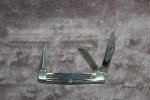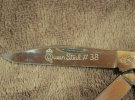- Joined
- Aug 5, 2011
- Messages
- 116
Hi all.
I recently won this Queen Steel stockman at a popular auction site. The knife is great. You can swap the spey for a punch on any stockman as far as I'm concerned. This one has winterbottom covers and measures about 3-[SUP]1[/SUP]/[SUB]2[/SUB]" closed. The blade etch reads "Queen Steel #38" and the tang has the Queen "Q" with "1922" and "1972" on opposing sides of the Q.
Pics from the auction to follow, but my questions first. Does the tang stamp indicate that this knife is from 1972? Also, can any of you tell me what the blade steel would be on this knife. My previous Queen stockman was D2, but it was alot more recent vintage. Did they use the same steel when this one was made? Something else? There is no sign of corrosion that I can see, in case that helps.




It does look better without so many fingerprints!
Thanks in advance!
I recently won this Queen Steel stockman at a popular auction site. The knife is great. You can swap the spey for a punch on any stockman as far as I'm concerned. This one has winterbottom covers and measures about 3-[SUP]1[/SUP]/[SUB]2[/SUB]" closed. The blade etch reads "Queen Steel #38" and the tang has the Queen "Q" with "1922" and "1972" on opposing sides of the Q.
Pics from the auction to follow, but my questions first. Does the tang stamp indicate that this knife is from 1972? Also, can any of you tell me what the blade steel would be on this knife. My previous Queen stockman was D2, but it was alot more recent vintage. Did they use the same steel when this one was made? Something else? There is no sign of corrosion that I can see, in case that helps.


It does look better without so many fingerprints!
Thanks in advance!
